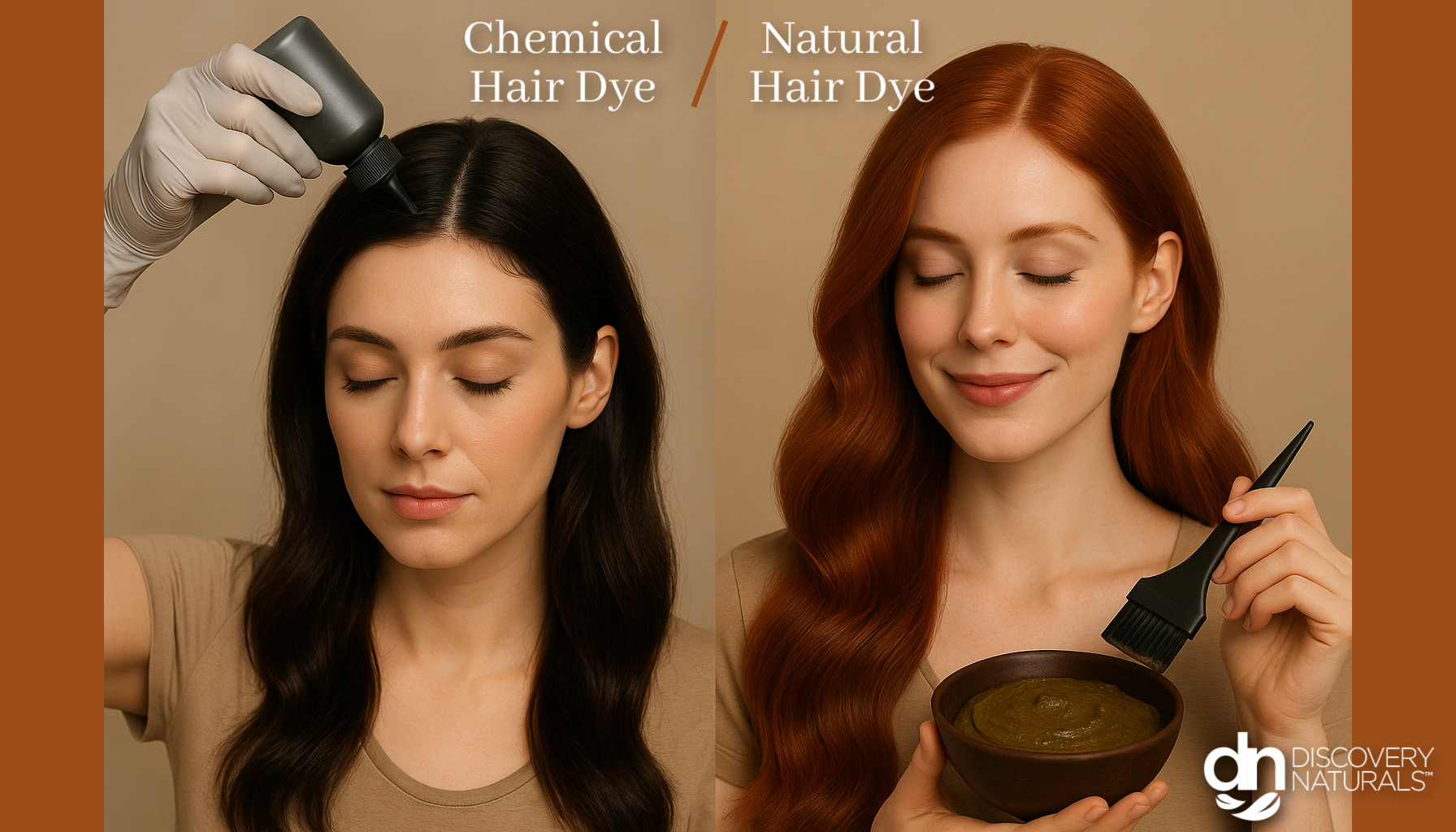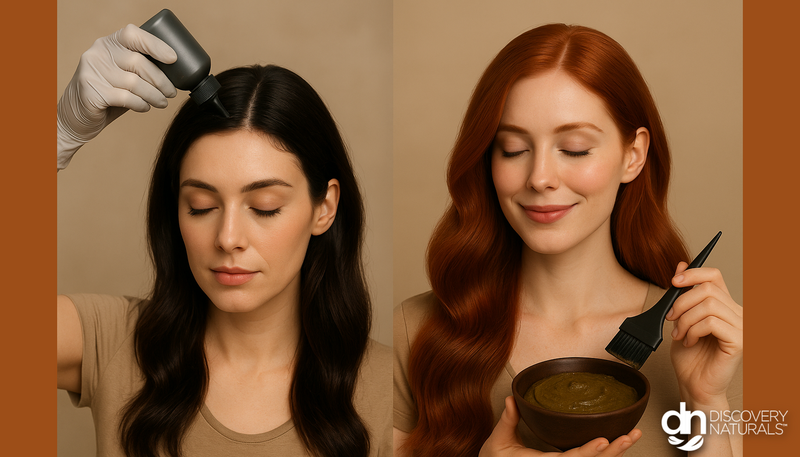Transitioning from Synthetic Hair Dye to Natural Henna: What You Need to Know
Making the switch from synthetic hair dye to natural henna can feel like a big leap—but it’s one of the most rewarding moves you can make for your hair health, scalp comfort, and long-term color vibrancy.
Whether you’re tired of harsh chemicals, allergic reactions, or just looking for a more sustainable approach to coloring, this guide will walk you through everything you need to know about transitioning to henna-based dye with Discovery Naturals.
Why Switch to Henna in the First Place?
Synthetic dyes rely on aggressive ingredients like ammonia, PPD (para-phenylenediamine), and peroxide to break down your hair’s natural structure and force artificial pigment into the strand. Over time, this process can:
- Damage the hair shaft
- Cause scalp irritation or allergies
- Lead to color that fades unevenly or turns brassy
- Strip natural shine and texture
Henna, on the other hand, is a plant-based, chemical-free dye made from the leaves of the Lawsonia inermis plant. It coats the hair shaft rather than penetrating it, which means:
- No structural damage to your hair
- Long-lasting, natural color that fades gradually
- Improved hair strength and shine
- Reduced risk of allergic reactions

What to Expect When Making the Transition
The most important thing to remember: switching to henna is a process, not a one-time fix. If your hair has been chemically treated for years, there may be buildup or damage that affects how henna adheres to the hair initially.
Here’s what to expect:
1. Your Color May Look Different at First
The result from your first henna application may be brighter or lighter than you expect. Don’t panic—henna oxidizes over 24 to 48 hours, deepening into a richer, more natural tone. Multiple applications will also help build up the pigment for better coverage and depth.
2. Gray Coverage Improves Over Time
Henna bonds more strongly to healthy, untreated hair. On grays, your first treatment might show as a golden or copper tone. A second application will typically deliver better coverage and a deeper, blended look.
3. You May Need to Detox Your Hair First
If you’ve been using synthetic dyes or products with silicones and sulfates, those ingredients may leave a coating on your hair that prevents henna from bonding effectively. Use a clarifying shampoo or a natural clay mask to remove buildup a few days before applying henna.
How to Prepare for Your First Henna Application
1. Do a Strand Test
Different hair types (porous, thick, gray) take henna differently. Before committing to a full-head application, test a small section. This helps you:
- Predict final color results
- Adjust timing for optimal saturation
- Avoid surprises
2. Choose the Right Shade
Discovery Naturals offers a range of henna-based shades—from Chestnut Medium Brown to Midnight Black and Ginger Natural Red—so you can customize your color journey. Use our Choosing the Right Natural Hair Dye guide to find the perfect match.
3. Mix and Let It Sit
Henna paste needs time for the dye to release. Mix your powder with warm water or lemon juice until it forms a thick, yogurt-like consistency. Let it sit for 30–60 minutes before applying.
The Application Process
Application is simple, and we break it down fully in our Step-by-Step Natural Hair Dye Guide. Here’s a quick overview:
- Apply to clean, dry hair
- Section your hair for easier control
- Use gloves to apply from roots to tips
- Cover with a shower cap and let sit 1–3 hours
- Rinse thoroughly with warm water (no shampoo for 24 hours)
Aftercare and Color Longevity
One of the benefits of henna is that it continues to develop and deepen in the days after application. To help the color last:
- Use sulfate-free shampoo and conditioner
- Avoid daily washing
- Protect your hair from UV and chlorine exposure
- Apply a henna gloss every 3–4 weeks to refresh your shade
Learn more: Maintaining & Prolonging Henna Hair Color

Common Questions
Can I go back to chemical dye later? Yes, but it’s best to wait a few weeks and do a strand test first. Some chemical dyes may react unpredictably with residual henna.
Is henna safe for sensitive skin? Absolutely. Discovery Naturals’ products are free of ammonia, PPD, and synthetic additives, making them ideal for allergy-prone users.
Will henna make my hair dry? Henna naturally strengthens and conditions hair. Still, using deep conditioning treatments helps keep your hair soft and manageable, especially during the transition.
Transitioning from synthetic hair dye to natural henna may take a little patience—but the results are well worth it. With vibrant color, improved hair health, and a more natural beauty routine, it’s a shift that pays off long term.
Ready to make the switch? Browse our full line of Natural Hair Dyes and take the first step toward a cleaner, greener color experience.

